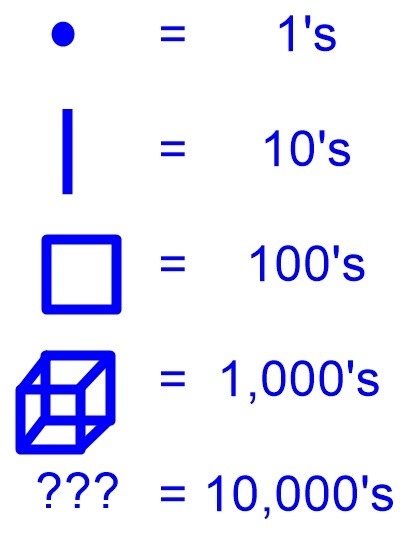Common Core and Fourth Dimensional Math
I couple of weeks ago, I saw a video on Twitter. In it, a girl tried to solve 1,568 + 1,423 + 680. First, she tried to solve it using a Common Core tactic. Next, she tried to solve it using the normal "stacking" method that kids have been learning for years. Take a look:
Not only did the Common Core method take her 10 times as long, but the complexity resulted in an incorrect answer. Meanwhile, the old-school stacking method was faster AND more accurate. Even if she had made an error using the stacking method, it would have been easier to check and would have taken less space to write out.
However, while watching this video, I saw another problem.

Doing the common core math, 1’s were represented by dots, 10’s were lines, 100’s were squares, and 1,000’s were cubes. Suppose the problem had been 15,680 instead of 1,568, though. How would the child have been able to represent this? Sure, she could draw 15 cubes, but the natural progression seems to be to add a dimension to the figure for each additional place value. Going by this logic, we’ll have grade school children drawing hypercubes to solve math equations.

Yes, a simple math problem like 15,682 + 23,624 would require tapping into the fourth dimension to solve. Clearly, this is yet another non-scalable Common Core method.
Why do we continue to confuse our kids when traditional math teaching methods work so much better?
In New York, sadly, the answer is that Governor Cuomo has decided that the public schools must go to clear the way for charter schools. He attacks teachers – even going so far as to insinuate that teachers oppose high stakes test scores being tied to their jobs to protect teachers having inappropriate relations with students – and calls public schools "monopolies" while he backs the charter schools and pushes for more of them. If Governor Cuomo has his way, all public schools would be charter schools run by private businesses. After all, privatization fixes everything, right?
The only bright spot is his claim to support "anti-creaming" legislation which would force charter schools to not only accept ESL, low income, and special needs students, but to report on how many they have at the beginning and end of every school year. Still, having one good idea doesn’t make me support all of the bad ideas he wants to implement.
Maybe it’s time to stop seeking overly complicated answers in the fourth dimension and when a real world simple solution is present. Fund public schools fairly and let our teachers teach instead of forcing them to focus on how well the students can perform on multiple high stakes tests. No hypercube is needed to solve this problem.
NOTE: The hypercube image above is by mate2code, was released into the public domain, and is available from Wikimedia Commons.

Well said!!!!
Mike Zamansky recently posted..Kids these days — they don’t know nuttin
I have never been any good at math. And I started looking into to common core math it confuses me so much. Had it been in place when I was in school I would have failed math before I could graduate. I was a straight A student until high school when we had to start taking algebra and geometry I was lost. Now with my kids and common core the more I read the more I refuse to let me kids learn that way so we homeschool. We use a curriculum that was set up 40 years ago and sadly? It was the standard in all schools then. Now? It’s advanced. Tell you something huh? Right now I am blessed to be a stay-at-home mom but my husband and I have talked many times and agree that even if we have to work opposite and never see each other keeping our kids homeschooled is a priority.
This method of solving problems by drawing the shapes is not new to Common Core. It may be “new” in New York, but where I’m from (AZ) we’ve been teaching it for many, many years. To me it is “traditional math teaching.” It is a way to visualize the value of the digits in each place. The shape of the pictures is related to place value blocks which contain interconnected cubes. It’s after studying this way for a while that the students are then taught the standard algorithm or “stacking” method, as you call it. And yes, while we are studying it, we ask them to forego any other methods they’ve learned at home until we get to that part of the unit. Eventually, everybody gets to the standard algorithm because it IS quicker once you understand what you are doing and why. While Common Core Math is far from perfect, the idea behind it is to understand why the “tricks” and quick methods for math work.